Month:
May, 2007
More on the Same Subject
Notice: Use of undefined constant the_post_thumbnail - assumed 'the_post_thumbnail' in /home/netscrib/public_html/civilwarcavalry/wp-content/themes/wittenberg/archive.php on line 65

Hat tip to reader Steve Ward, who told me about this in a comment to the last blog post….
There is an article on the topic of the duration of copyright protection in the business section of today’s New York Times. This is obviously an important topic that is receiving a great deal of attention in a number of different sectors.
Perhaps Congress needs to step up and clarify some of these issues so that researchers know what they can and cannot do with a given source.
Scridb filterCopyright and Unpublished Manuscript Materials
Notice: Use of undefined constant the_post_thumbnail - assumed 'the_post_thumbnail' in /home/netscrib/public_html/civilwarcavalry/wp-content/themes/wittenberg/archive.php on line 65

Chris Wehner had an interesting post on his blog the other day on historical documents and copyright. Someone asked Chris who owns the copyright for historical documents.
Copyright can be kind of a tricky concept to wrap one’s arms around. You cannot copyright an idea, only the expression of that idea. Thus, I had an idea to write a book about the Battle of Monroe’s Crossroads. That idea, in and of itself, cannot be copyrighted. The book itself–how I expressed that idea–is what is subject to copyright protection. Once we get our arms around that concept, we can then move on to the more difficult question of what is and is not in the public domain.
The first issue, of course, is whether anyone has copyright rights to a given document. For instance, official government documents are, by definition, in the public domain and not subject to copyright. Anyone can use them for whatever purpose they please. Thus, virtually everything in the collection of the National Archives and Records Administration is in the public domain, as they are official government records. The same probably holds true for state governmental archives as well. I believe it also applies to things like the manuscripts collection at the Library of Congress.
Where it gets trickier is with material in non-governmental repositories such as universities and local historical societies. The following passage comes directly from the United States Copyright Office web site regarding the question of how long copyright protection lasts:
Works Originally Created on or after January 1, 1978A work that was created (fixed in tangible form for the first time) on or after January 1, 1978, is automatically protected from the moment of its creation and is ordinarily given a term enduring for the author’s life plus an additional 70 years after the author’s death. In the case of “a joint work prepared by two or more authors who did not work for hire,†the term lasts for 70 years after the last surviving author’s death. For works made for hire, and for anonymous and pseudonymous works (unless the author’s identity is revealed in Copyright Office records), the duration of copyright will be 95 years from publication or 120 years from creation, whichever is shorter.Works Originally Created before January 1, 1978, But Not Published or Registered by That DateThese works have been automatically brought under the statute and are now given federal copyright protection. The duration of copyright in these works is generally computed in the same way as for works created on or after January 1, 1978: the life-plus-70 or 95/120-year terms apply to them as well. The law provides that in no case would the term of copyright for works in this category expire before December 31, 2002, and for works published on or before December 31, 2002, the term of copyright will not expire before December 31, 2047.Works Originally Created and Published or Registered before January 1, 1978
Under the law in effect before 1978, copyright was secured either on the date a work was published with a copyright notice or on the date of registration if the work was registered in unpublished form. In either case, the copyright endured for a first term of 28 years from the date it was secured. During the last (28th) year of the first term, the copyright was eligible for renewal. The Copyright Act of 1976 extended the renewal term from 28 to 47 years for copyrights that were subsisting on January 1, 1978, or for pre-1978 copyrights restored under the Uruguay Round Agreements Act (URAA), making these works eligible for a total term of protection of 75 years. Public Law 105-298, enacted on October 27, 1998, further extended the renewal term of copyrights still subsisting on that date by an additional 20 years, providing for a renewal term of 67 years and a total term of protection of 95 years.
Public Law 102-307, enacted on June 26, 1992, amended the 1976 Copyright Act to provide for automatic renewal of the term of copyrights secured between January 1, 1964, and December 31, 1977. Although the renewal term is automatically provided, the Copyright Office does not issue a renewal certificate for these works unless a renewal application and fee are received and registered in the Copyright Office.
Public Law 102-307 makes renewal registration optional. Thus, filing for renewal registration is no longer required to extend the original 28-year copyright term to the full 95 years. However, some benefits accrue to renewal registrations that were made during the 28th year.
The big question is whether one must obtain permission to use materials in university and local historical society collections. I usually take the position that, irrespective of what the university or historical society says, this material is in the public domain and that I don’t need permission to use it, and that I certainly don’t need to pay for the privilege of using it. The author has certainly been dead for longer than the requisite period and the material has never been published. Consequently, I don’t see how it can be subject to, or covered by, copyright protection so many years after the fact. I’ve said that I’m willing to take that fight on, as I am confident that I will prevail. However, I could also be convinced that I’m wrong about this. I have two readers of this blog who could probably contribute a great deal to this discussion. Lawrence Ebert is an intellectual property lawyer who maintains an interesting blog devoted to the business of intellectual property, and Art Bergeron is an archivist at the United States Army Military History Institute. I would really appreciate and welcome their input into this interesting issue.
Scridb filterMemorial Day 2007
Notice: Use of undefined constant the_post_thumbnail - assumed 'the_post_thumbnail' in /home/netscrib/public_html/civilwarcavalry/wp-content/themes/wittenberg/archive.php on line 65

Old men forget: yet all shall be forgot,
But he’ll remember with advantages
What feats he did that day: then shall our names.
Familiar in his mouth as household words
Harry the king, Bedford and Exeter,
Warwick and Talbot, Salisbury and Gloucester,
Be in their flowing cups freshly remember’d.
This story shall the good man teach his son;
And Crispin Crispian shall ne’er go by,
From this day to the ending of the world,
But we in it shall be remember’d;
We few, we happy few, we band of brothers;
For he to-day that sheds his blood with me
Shall be my brother; be he ne’er so vile,
This day shall gentle his condition:
And gentlemen in England now a-bed
Shall think themselves accursed they were not here,
And hold their manhoods cheap whiles any speaks
That fought with us upon Saint Crispin’s day.
–William Shakespeare
Henry V, Act 4, Scene III
I’ve been watching Band of Brothers on The History Channel for much of the day. This magnificent miniseries never ceases to move me immensely. These men were truly the Greatest Generation.
Thank you to all American veterans of all branches of services, past, present, and future. Thank you for everything you have done to ensure that we Americans continue to enjoy liberties that we probably never fully appreciate. Thank you for your sacrifices on our behalf, for leaving your families to serve and protect us. And to those who have made the ultimate sacrifice, we owe you the greatest debt of gratitude of all.
Today is also Susan’s birthday. Happy birthday to my best friend, companion, and favorite battlefield stomping buddy.
Scridb filterRemaindering Update
Notice: Use of undefined constant the_post_thumbnail - assumed 'the_post_thumbnail' in /home/netscrib/public_html/civilwarcavalry/wp-content/themes/wittenberg/archive.php on line 65

 As mentioned in my prior post, I recently learned that Potomac Books intends to remainder my book The Union Cavalry Comes of Age: Hartwood Church to Brandy Station, 1863. Consequently, I e-mailed the publisher, Sam Dorrance, to request that they either bring the book back into print or revert my publishing rights to me, so that I could take the book elsewhere in the hope of keeping it in print.
As mentioned in my prior post, I recently learned that Potomac Books intends to remainder my book The Union Cavalry Comes of Age: Hartwood Church to Brandy Station, 1863. Consequently, I e-mailed the publisher, Sam Dorrance, to request that they either bring the book back into print or revert my publishing rights to me, so that I could take the book elsewhere in the hope of keeping it in print.
Sam wrote me back on Friday to let me know that only the hardcover edition is being remaindered, as sales have slowed to almost nothing. However, he indicated that sales of the softcover edition remain steady, and that the softcover edition is not being remaindered. He also indicated that when the time comes to remainder the softcover edition, my rights would be reverted to me.
That’s great news on both counts. I’m still not entirely happy with being remaindered at all, but I understand making business decisions, and at least the softcover edition will remain in print for the foreseeable future. Since my object was to ensure that the book remains in print, I feel like I accomplished my goal.
Scridb filterPassages
Notice: Use of undefined constant the_post_thumbnail - assumed 'the_post_thumbnail' in /home/netscrib/public_html/civilwarcavalry/wp-content/themes/wittenberg/archive.php on line 65

Susan and I went to Pittsburgh for the day yesterday to attend the wedding of some close friends. There was something extremely appropriate about my being in the Steel City yesterday. Yesterday was the 20th anniversary of my graduation from the University of Pittsburgh School of Law. I moved to Columbus on June 1, 1987, and I’ve been here ever since.
It hardly seems possible that twenty years have passed since that roasting hot, humid day, but they clearly have. If you had asked me then whether I’d still be here in Columbus twenty years later, I would have told you that you were out of your mind, but it’s true. And so it goes…..
Scridb filterBeing Remaindered….
Notice: Use of undefined constant the_post_thumbnail - assumed 'the_post_thumbnail' in /home/netscrib/public_html/civilwarcavalry/wp-content/themes/wittenberg/archive.php on line 65

Well, it’s happened again. Potomac Books, in its infinite wisdom, has decided to remainder me again. This time, it’s one of my very favorite books, and one that has a very large investment of me in it, The Union Cavalry Comes of Age: Hartwood Church to Brandy Station, 1863. That means that I will see something that I hate: one of my titles on the shelf at Half Price Books, marked down to next to nothing. It also means that I don’t get paid royalties on the remaindering sales.
I understand that publishing is a business and that publishers have to turn inventory. I get that. I also understand that warehouse space is expensive and that they need to move their inventory. I get that, too. In short, I realize that it’s just business and not personal. However, no matter how hard I try, I end up taking it personally, like there’s something inadequate about my work that makes it unworthy of being kept in print.
At the same time, it seems to me that some books that are steady sellers should be kept in print. This book has sold steadily but not spectacularly, but it’s a solid performer.
The last time that they remaindered one of my books, the University of Nebraska Press picked it up for inclusion in their Bison Books trade paperback series.
My contract with Potomac Books gives me the right to request that they bring my book back into print, or else my publishing rights revert to me if they don’t do so within six months of the request. I intend to make that request in the next ten days, and if they don’t bring the book back into print as requested, I will get my rights back and offer this one to Bison Books as well.
Stay tuned. I will keep everyone posted.
Scridb filterAn Interesting Perspective on Carhart’s Nonsense
Notice: Use of undefined constant the_post_thumbnail - assumed 'the_post_thumbnail' in /home/netscrib/public_html/civilwarcavalry/wp-content/themes/wittenberg/archive.php on line 65

Lawrence B. Ebert is a registered patent lawyer from New Jersey. He maintains a blog called IPBiz that deals with the business of intellectual property. He has commented on this blog previously, and he also is an active member of the CWDG.
Last week, Mr. Ebert had an interesting post on plagiarism, and he selected Carhart’s festering pile of turds as the example for analysis. Referring to Paul D. Walker’s The Cavalry Battle that Saved the Union, which is, without doubt, one of the worst Civil War books ever published, Ebert points out that Walker’s book also claims that Stuart’s movement on East Cavalry Field was coordinated with Pickett’s Charge. Walker’s book, awful as it may be–and it is horrendous–was published a couple of years before Carhart’s. Mr. Ebert wrote, “The later guy in town had better credentials, better friends, and a better publisher, and few even knew of the earlier guy. How can ‘you know it when you see it’?”
On April 26, he also put up an extended post about the accounts of the veterans of the fight on East Cavalry Field wherein they addressed the theory that is the underpinning of Carhart’s theory. Following a lead that I gave him on the CWDG, he focused in on William Brooke-Rawle’s account of the fight on East Cavalry Field, wherein Brooke-Rawle stated, “It was obvious that he [Stuart] intended to accomplish this by way of the Baltimore Pike and the roads hereafter described, simultaneously with Pickett’s attack in front.”
The gist, therefore, is that Mr. Ebert appears to believe that Tom Carhart is a plagiarist who has claimed a novel theory as his own when it’s something that has been around for decades and is nothing new at all. I agree. I also have major issues with the fact that Carhart simply made stuff up. The combination of making stuff up and plagiarism equals fraud on the consuming public.
My hat’s off to Mr. Ebert for showing this festering pile of turds for what it really is.
Scridb filterPhotos from the Trip
Notice: Use of undefined constant the_post_thumbnail - assumed 'the_post_thumbnail' in /home/netscrib/public_html/civilwarcavalry/wp-content/themes/wittenberg/archive.php on line 65

Below are photos from the recent trip to North Carolina. The first photograph is of a Confederate light saber recovered from the Monroe’s Crossroads battlefield that is owned by a fellow named Al Potts. The wrist guard is bent, but Mr. Potts does not know whether it is battle damage. The blade is pretty chewed up, but I couldn’t tell if it was from battle or from being exposed to the elements. The next batch of photos are from the Guilford Court House National Military Park. There are 32 monuments on the Guilford Court House battlefield and we photographed most of them. The last batch of pictures are from the Jeb Stuart birthplace.
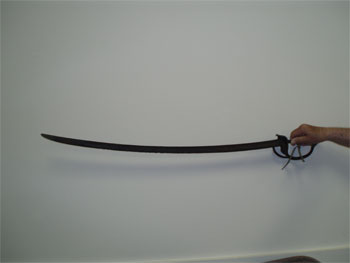
This is Al Pott’s Ames Confederate saber, found on the Monroe’s Crossroads battlefield before it was part of Fort Bragg. It’s oxidized black. The blade, as you can see, is in rough shape. The wrist guard is damaged.
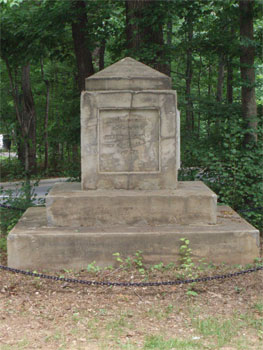
This is the grave of Brig. Gen. Jethro Sumner, who commanded the 3rd North Carolina Infantry from 1776-1780. At the time of the Battle of Guilford Court House, he was a colonel. His unit did not fight in the battle. It was on detached duty in Hillsborough. However, Sumner was buried on the battlefield in 1891.
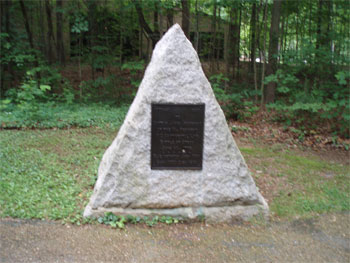
This is a monument to Capt. James Morehead. His descendant was one of the founders of the company that erected these monuments before the National Park Service acquired the land that makes up the park. The monument is shaped like a pup tent in honor of Morehead’s military service.

There are two monuments to women on the battlefield. Karrenhappuch Norman Turner was an ancestor of the Morehead family. According to family legend, she supposedly rode from Maryland to tend a seriously wounded son after the battle. The cup and towel in the statue’s hands were the simple tools of her care.
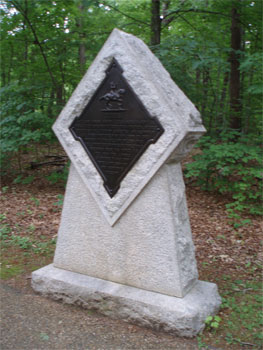
This is the Bugler Gillies Monument. James Gillies was a young bugler in “Lighthorse Harry” Lee’s Legion, killed by Tarleton’s British cavalry in February 1781 near present-day Oak Ridge.
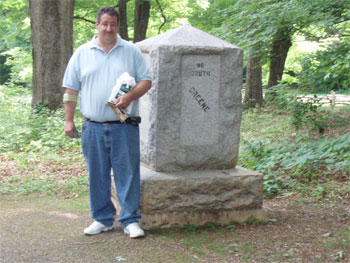
Me standing by the “No North, No South” monument, which was dedicated in 1903. It has Nathanael Greene’s name on one side with the word “South” and George Washington’s name on the other with the word “north”. The people who saw the split of the nation due to the Civil War in 1861 erected this monument to renewed nationalism. Greene, a New Englander, led southern troops while Washington, a southerner, led northern troops.
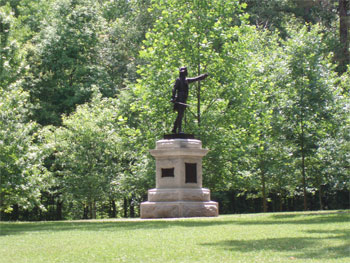
This is the Joseph Winston monument. It’s located on the end of the second American battle line. Major Joseph Winston commanded the Surry County, North Carolina militia in the battle.

This handsome equestrian monument was dedicated in 1915. It depicts the American commander, Maj. Gen. Nathanael Greene. Greene was perhaps the finest of all of George Washington’s subordinates. The battle plan–a defense in depth–was designed by Greene, who earned the respect of his British counterpart, Charles Cornwallis.

This monument commemorates the three Tarheels who signed the Declaration of Independence and marks the graves of two of them. William Hooper, Joseph Hewes, and John Penn all signed the Declaration of Independence in 1776. Hooper’s and Penn’s remains were re-bruied in the park in 1897, while Hewes’ remains lie in Christ Churchyard in Philadelphia. The monument and remains were moved to the present location in 1976. The bronze statue is of Hooper, the “Orator of the Congress”.
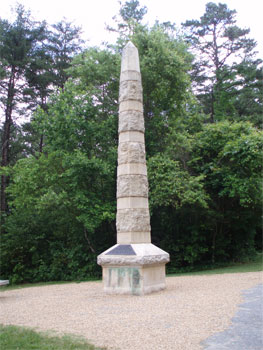
The American cavalry was honored by this monument. Two bronze tablets honor the “Virginia Giant” Peter Francisco, who killed eleven men with his broadsword during the Battle of Guilford Court House, Lt. Col. William Washington (cousin of George Washington, and commander of the American cavalry), and the Marquis de Britigny, a French volunteer.
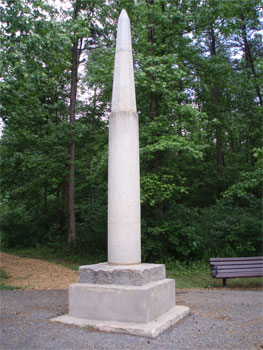
This is a monument to the Continental Regulars of Greene’s army. It was also supposed to mark the third American line of battle, but subsequent research has shown that it is misplaced by about a quarter of a mile. The real third line position was at the original county court house site, which sat atop a prominent ridge. Greene chose this position wisely, and it was stoutly defended by his Continentals.

This is the James Stuart monument, which is the only monument on the battlefield to a British soldier. Lt. Colonel James Stewart (as spelled on British military documents) of the Brigade of Guards was killed in the fighting on the third line. The monument marks the spot where a sword was found in 1866. The sword was engraved with the coat of arms of the Bllantyre family, connecting it to Stewart.

I took this beautiful panoramic view standing at the monument to the Continentals. The Stuart monument is partway down the ridge. You can see the Cavalry Monument in the distance on the other side of the valley. As stated above, the men who marked the field originally believed that this was the position of the American third line, but it wasn’t. I include this photo for a couple of reasons. First, you can see how beautiful this park is. Second, you can get a sense of the rolling terrain and very dense woods that played a major role in the development of this battle.
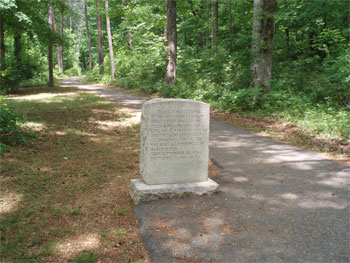
This was the last monument placed on the Guilford Court House battlefield in 1932. Capt. Griffin Murdock Fauntleroy of Northumberland County, Virginia was one of the most experienced soldiers in Nathanael Greene’s army. After serving in the 7th Virginia Infantry, he resigned his commission and instead accepted one as a captain in the First Continental Light Dragoons. He was mortally wounded and left on the battlefield at Guilford Court House.
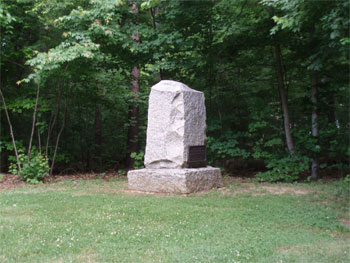
This is a monument to Nathaniel Macon, an officer in Greene’s army who left just before the battle to fill an elected seat in the North Carolina Assembly. He eventually became the Speaker of the United States House of Representatives.
That’s it for the Guilford Court House photos. The next batch come from the Jeb Stuart birthplace.
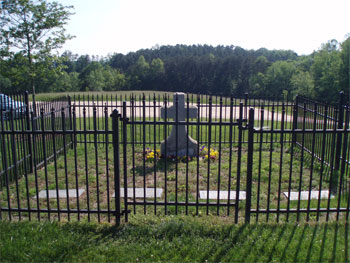
This fence and the cross are the original site of the graves of Jeb Stuart’s parents. The bodies were later disinterred and moved. However, they were an important part of the family farm, and their location remains marked by these cenotaphs today.
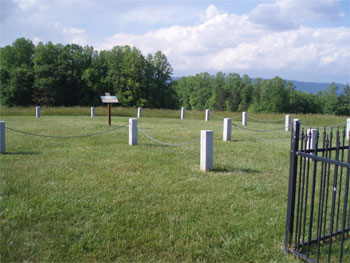
The family home burned in the 1840’s. Archaeologists have located the foundation. The granite markers show the perimeter of the house. Jeb Stuart was born in the house.
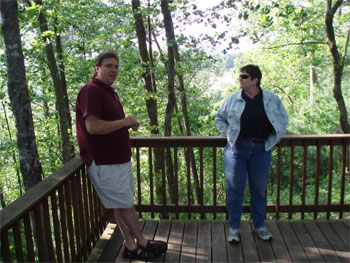
The Jeb Stuart Birthplace sits on a high ridge, overlooking the mighty Ararat River and the 1500 acres owned by Archibald Stuart. Jeb Stuart’s maternal great-grandfather, William Letcher, was a patriot. British Tories killed him during the Revolutionary War, and he was buried in the valley overlooking the mighty Ararat. It’s in the valley below. With Susan in this photo is Thomas D. Perry, whose efforts are responsible for saving and preserving the Jeb Stuart Birthplace.
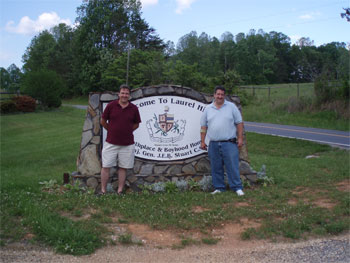
Tom and me by the big sign that marks the entry to the Birthplace property.
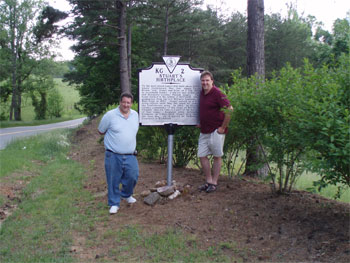
Tom and me by the Virginia state historical marker just outside the Birthplace property. Tom says that the prior version of this sign is what got him interested in Jeb Stuart and in the Civil War.
That’s it for the photos from this trip. I hope you’ve enjoyed them.
Scridb filterThe Horror
Notice: Use of undefined constant the_post_thumbnail - assumed 'the_post_thumbnail' in /home/netscrib/public_html/civilwarcavalry/wp-content/themes/wittenberg/archive.php on line 65

A week ago today, I had a horrifying realization, one I’ve been dreading for a LONG time.
We had dinner with another couple and then went to see Spiderman III. When we got to their house, I grabbed the newspaper to make sure of the times when the movie was playing, and realized that….I couldn’t read the fine print with the movie times!!! Rather suddenly, my arms had grown too short.
I had to borrow my friend Mark’s reading glasses in order to read the movie times. I’m 46, and I knew this day was coming, sooner than later. The next day, last Sunday, we went to Costco and I bought three pairs of +1.25 reading glasses for $18. That way, I have one pair for upstairs, one for downstairs, and one for the office.
The other night, after my talk in Pinehurst, a fellow brought up a photocopy of some information he thought I might be interested in, but the print was too small, and I didn’t have my reading glasses with me. I had to do the old hold the page as far away as I could so I could read it bit, and I suddenly felt VERY old. 🙁
There are some very effective bifocal contact lenses out there now. I’m hoping I might be eligible for them…..
Scridb filterThe Trip
Notice: Use of undefined constant the_post_thumbnail - assumed 'the_post_thumbnail' in /home/netscrib/public_html/civilwarcavalry/wp-content/themes/wittenberg/archive.php on line 65

We’re home safe and sound, but very, very tired.
We were up at 5:30 on Thursday morning to get the dogs to the fabulous place where we board them when we go out of town. We hit the road at 8:00. It is every bit of an eight hour drive to Pinehurst, not like the typo in my last post suggested. We got to Teej’s house about 4:15. We visited a bit, and then checked into the hotel. After dropping off our stuff, we headed out to dinner and then to the CWRT meeting.
The program chair didn’t bother to coordinate with me, so I wasn’t sure what I was expected to talk about. I figured I would do the Western Theater talk that I did in Nashville in March, but when I got there, I discovered that they were expecting me to do my Monroe’s Crossroads talk. I was able to pull it off, but if I had known that was what they expected, I would have brushed up on some of the names. It’s been a while since I’ve done that talk–at least six months–so I struggled with some of the names. Nevertheless, it went well. The highlight of the evening was that a fellow named Al Potts brought along a Confederate saber found on the battlefield, years before it was part of Fort Bragg. Tomorrow night, Susan will post a bunch of photos from the trip, including one of the saber.
After having breakfast with Teej, we headed off to see the Guilford Court House National Military Park, site of the crucial 1781 battle between Maj. Gen. Nathaniel Greene’s Army of the South and Lt. Gen. Charles Cornwallis’ army. In this action, Greene incorporated the same tactics used at Cowpens, and designed a defense in depth consisting of three distinct lines of battle. Greene’s army consisted of about 4,000 men, while the British had about 1,900. After a long and bloody fight, Greene’s army was eventually driven from the field, but not before imposing heavy losses on Cornwallis, including his second-in-command, Maj. Gen. Charles O’Hara, who was wounded twice. Cornwallis was so badly bloodied that he ended up retreating into Virginia, winding up at Yorktown. There are 32 monuments on the battlefield at Guilford, including a gorgeous equestrian monument to Greene, so we will post photos of most of them tomorrow. Sadly, only about 25% of the battlefield (about 220 acres) is within the park boundaries, while the rest of it has been lost to the suburban sprawl of Greensboro. Fortunately, the most important portion of the battlefield is preserved and protected, and it’s a beautiful park. I bought two books on Guilford Court House and one on the Battle of Camden at the park’s excellent little book store. I really would like to go back again with someone who is intimately acquainted with the battlefield and get a detailed tactical tour sometime soon.
After lunch, we headed north. We stopped at the largest winery in the Yadkin Valley, the Shelton Vineyards, which are in Dobson. The vineyards, which are quite extensive, are on the grounds of an old tobacco farm; many tobacco farms have been converted to vineyards very successfully. The vines are all young–none are older than about 13 years old–but they produce some interesting young wines. We tasted a flight of five red wines and bought a few bottles and then headed on to Mt. Airy, where we spent the night last night.
Mt. Airy is an old town, situated just a few miles south of the line dividing North Carolina and Virginia. It boasts a lot of history. Chang and Eng Bunker, the famous Siamese Twins, lived there. Jeb Stuart was born and raised a few miles away, and the family went to church there. Maj. Gen. George Stoneman’s raiders visited it during their March 1865 raid through southwestern Virginia and North Carolina. However, Mt. Airy is most famous as Andy Griffith‘s home town, and as the model for Mayberry, R.F.D. Floyd’s barbership is still there. There’s a statue to Andy and Opie at the fishing hole located at a theater named for Andy Griffith. There’s a restaurant called Aunt Bea’s. Next door to Aunt Bea’s is a restaurant called Goober’s. You get the idea. Everything is called Mayberry there, and everywhere you look, people are selling Mayberry, RFD souvenirs. Apparently, a tremendous number of tourists come every year to partake of Mayberry’s mythology. It’s really pretty amazing.
Old friend Hokie Tom Perry then took us to his hometown, nearby Ararat, VA, which, quite coincidentally, is the where Jeb Stuart was born. Tom is largely responsible for the preservation of Laurel Hill, Stuart’s birthplace. Tom showed us around–I’d never been there. The house burned over 100 years ago, but archaeologists have located it, and its footprint is clearly marked. It’s a neat site, and one I’m glad I finally got to see.
That evening, there was a fundraiser at the local country club for the Mt. Airy Museum of Regional History. Tom’s girlfriend is the curator of collections at the museum, so Tom was able to arrange tickets for us. It was a very nice dinner with talks by two novelists. Judge Martin Clark lives in Patrick County, Virginia. When not presiding on the bench, he’s a novelist of some reknown, and a very funny speaker. He led off and was then followed by David Baldacci, whose new book Simple Genius, is presently number one on the New York Times bestseller list. He’s an ex-lawyer and now is a full-time writer. He has 57,000,000 books in print in something like 41 languages. I know what they paid for him to appear there last night. Both of these guys are lawyers and writers. Martin recently sold the movie rights to his first novel. Baldacci must make astonishing amounts of money with the way his books sell; his advance for his first novel was the largest ever paid for a first-time novelist at the time. It was called Absolute Power, and it was later turned into a pretty darned good Clint Eastwood movie. Let’s just say that I am definitely in the wrong business writing Civil War history. 🙂 Baldacci was also very funny, and then there was a book signing.
We then visited with Tom and his girlfriend Amy at Amy’s lovely home for a couple of hours, and by the time we got back to the hotel, it was nearly 1:00 AM. Yesterday was a very long but very fun day.
Today, we got up about 8, packed up, had breakfast, and hit the road. We were home by 4:00 this afternoon. We had dinner, and now we’re in for the night. The dogs were thrilled to see us, but I think they’re as tired as we are. I suspect it may be an early night for all five of us. 🙂
Photos will post tomorrow.
Scridb filterNotice: Undefined index: id in /home/netscrib/public_html/civilwarcavalry/wp-content/themes/wittenberg/footer.php on line 8
Notice: Undefined index: id in /home/netscrib/public_html/civilwarcavalry/wp-content/themes/wittenberg/footer.php on line 8
Notice: Undefined index: std in /home/netscrib/public_html/civilwarcavalry/wp-content/themes/wittenberg/footer.php on line 8
Notice: Undefined index: id in /home/netscrib/public_html/civilwarcavalry/wp-content/themes/wittenberg/footer.php on line 8
Notice: Undefined index: id in /home/netscrib/public_html/civilwarcavalry/wp-content/themes/wittenberg/footer.php on line 8
Notice: Undefined index: std in /home/netscrib/public_html/civilwarcavalry/wp-content/themes/wittenberg/footer.php on line 8
Notice: Undefined index: id in /home/netscrib/public_html/civilwarcavalry/wp-content/themes/wittenberg/footer.php on line 8
Notice: Undefined index: id in /home/netscrib/public_html/civilwarcavalry/wp-content/themes/wittenberg/footer.php on line 8
Notice: Undefined index: std in /home/netscrib/public_html/civilwarcavalry/wp-content/themes/wittenberg/footer.php on line 8
Notice: Undefined index: id in /home/netscrib/public_html/civilwarcavalry/wp-content/themes/wittenberg/footer.php on line 8
Notice: Undefined index: id in /home/netscrib/public_html/civilwarcavalry/wp-content/themes/wittenberg/footer.php on line 8
Notice: Undefined index: std in /home/netscrib/public_html/civilwarcavalry/wp-content/themes/wittenberg/footer.php on line 8
Notice: Undefined index: id in /home/netscrib/public_html/civilwarcavalry/wp-content/themes/wittenberg/footer.php on line 8
Notice: Undefined index: id in /home/netscrib/public_html/civilwarcavalry/wp-content/themes/wittenberg/footer.php on line 8
Notice: Undefined index: std in /home/netscrib/public_html/civilwarcavalry/wp-content/themes/wittenberg/footer.php on line 8
Notice: Undefined index: id in /home/netscrib/public_html/civilwarcavalry/wp-content/themes/wittenberg/footer.php on line 8
Notice: Undefined index: id in /home/netscrib/public_html/civilwarcavalry/wp-content/themes/wittenberg/footer.php on line 8
Notice: Undefined index: std in /home/netscrib/public_html/civilwarcavalry/wp-content/themes/wittenberg/footer.php on line 8
Notice: Undefined index: id in /home/netscrib/public_html/civilwarcavalry/wp-content/themes/wittenberg/footer.php on line 8
Notice: Undefined index: id in /home/netscrib/public_html/civilwarcavalry/wp-content/themes/wittenberg/footer.php on line 8
Notice: Undefined index: std in /home/netscrib/public_html/civilwarcavalry/wp-content/themes/wittenberg/footer.php on line 8
Notice: Undefined index: id in /home/netscrib/public_html/civilwarcavalry/wp-content/themes/wittenberg/footer.php on line 8
Notice: Undefined index: id in /home/netscrib/public_html/civilwarcavalry/wp-content/themes/wittenberg/footer.php on line 8
Notice: Undefined index: std in /home/netscrib/public_html/civilwarcavalry/wp-content/themes/wittenberg/footer.php on line 8
Notice: Undefined index: id in /home/netscrib/public_html/civilwarcavalry/wp-content/themes/wittenberg/footer.php on line 8
Notice: Undefined index: id in /home/netscrib/public_html/civilwarcavalry/wp-content/themes/wittenberg/footer.php on line 8
Notice: Undefined index: std in /home/netscrib/public_html/civilwarcavalry/wp-content/themes/wittenberg/footer.php on line 8
Notice: Undefined index: id in /home/netscrib/public_html/civilwarcavalry/wp-content/themes/wittenberg/footer.php on line 8
Notice: Undefined index: id in /home/netscrib/public_html/civilwarcavalry/wp-content/themes/wittenberg/footer.php on line 8
Notice: Undefined index: std in /home/netscrib/public_html/civilwarcavalry/wp-content/themes/wittenberg/footer.php on line 8
Notice: Undefined index: id in /home/netscrib/public_html/civilwarcavalry/wp-content/themes/wittenberg/footer.php on line 8
Notice: Undefined index: id in /home/netscrib/public_html/civilwarcavalry/wp-content/themes/wittenberg/footer.php on line 8
Notice: Undefined index: std in /home/netscrib/public_html/civilwarcavalry/wp-content/themes/wittenberg/footer.php on line 8
Notice: Undefined index: id in /home/netscrib/public_html/civilwarcavalry/wp-content/themes/wittenberg/footer.php on line 8
Notice: Undefined index: id in /home/netscrib/public_html/civilwarcavalry/wp-content/themes/wittenberg/footer.php on line 8
Notice: Undefined index: std in /home/netscrib/public_html/civilwarcavalry/wp-content/themes/wittenberg/footer.php on line 8
Notice: Undefined index: id in /home/netscrib/public_html/civilwarcavalry/wp-content/themes/wittenberg/footer.php on line 8
Notice: Undefined index: id in /home/netscrib/public_html/civilwarcavalry/wp-content/themes/wittenberg/footer.php on line 8
Notice: Undefined index: std in /home/netscrib/public_html/civilwarcavalry/wp-content/themes/wittenberg/footer.php on line 8
Notice: Undefined index: id in /home/netscrib/public_html/civilwarcavalry/wp-content/themes/wittenberg/footer.php on line 8
Notice: Undefined index: id in /home/netscrib/public_html/civilwarcavalry/wp-content/themes/wittenberg/footer.php on line 8
Notice: Undefined index: std in /home/netscrib/public_html/civilwarcavalry/wp-content/themes/wittenberg/footer.php on line 8
Notice: Undefined index: id in /home/netscrib/public_html/civilwarcavalry/wp-content/themes/wittenberg/footer.php on line 8
Notice: Undefined index: id in /home/netscrib/public_html/civilwarcavalry/wp-content/themes/wittenberg/footer.php on line 8
Notice: Undefined index: std in /home/netscrib/public_html/civilwarcavalry/wp-content/themes/wittenberg/footer.php on line 8
Notice: Undefined index: id in /home/netscrib/public_html/civilwarcavalry/wp-content/themes/wittenberg/footer.php on line 8
Notice: Undefined index: id in /home/netscrib/public_html/civilwarcavalry/wp-content/themes/wittenberg/footer.php on line 8
Notice: Undefined index: std in /home/netscrib/public_html/civilwarcavalry/wp-content/themes/wittenberg/footer.php on line 8
Notice: Undefined index: id in /home/netscrib/public_html/civilwarcavalry/wp-content/themes/wittenberg/footer.php on line 8
Notice: Undefined index: id in /home/netscrib/public_html/civilwarcavalry/wp-content/themes/wittenberg/footer.php on line 8
Notice: Undefined index: std in /home/netscrib/public_html/civilwarcavalry/wp-content/themes/wittenberg/footer.php on line 8
Notice: Undefined index: id in /home/netscrib/public_html/civilwarcavalry/wp-content/themes/wittenberg/footer.php on line 8
Notice: Undefined index: id in /home/netscrib/public_html/civilwarcavalry/wp-content/themes/wittenberg/footer.php on line 8
Notice: Undefined index: std in /home/netscrib/public_html/civilwarcavalry/wp-content/themes/wittenberg/footer.php on line 8
Notice: Undefined index: id in /home/netscrib/public_html/civilwarcavalry/wp-content/themes/wittenberg/footer.php on line 8
Notice: Undefined index: id in /home/netscrib/public_html/civilwarcavalry/wp-content/themes/wittenberg/footer.php on line 8
Notice: Undefined index: std in /home/netscrib/public_html/civilwarcavalry/wp-content/themes/wittenberg/footer.php on line 8
Notice: Undefined index: id in /home/netscrib/public_html/civilwarcavalry/wp-content/themes/wittenberg/footer.php on line 8
Notice: Undefined index: id in /home/netscrib/public_html/civilwarcavalry/wp-content/themes/wittenberg/footer.php on line 8
Notice: Undefined index: std in /home/netscrib/public_html/civilwarcavalry/wp-content/themes/wittenberg/footer.php on line 8
Notice: Undefined index: id in /home/netscrib/public_html/civilwarcavalry/wp-content/themes/wittenberg/footer.php on line 8
Notice: Undefined index: id in /home/netscrib/public_html/civilwarcavalry/wp-content/themes/wittenberg/footer.php on line 8
Notice: Undefined index: std in /home/netscrib/public_html/civilwarcavalry/wp-content/themes/wittenberg/footer.php on line 8








 Back to top
Back to top Blogs I like
Blogs I like 